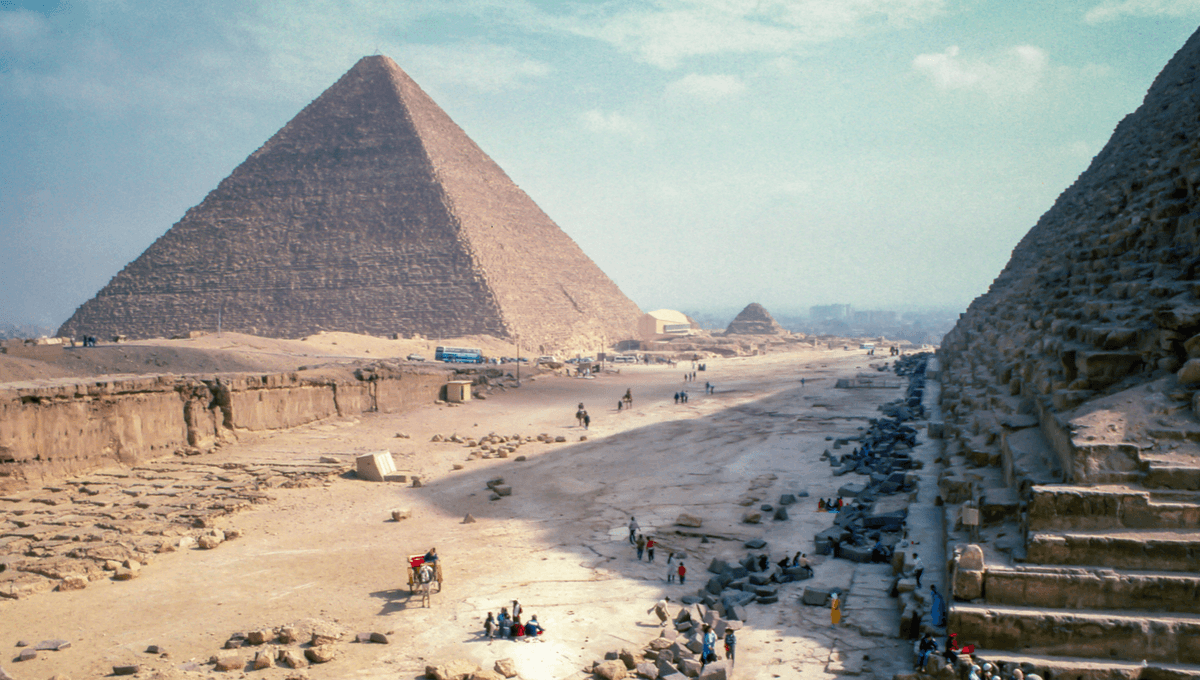
What on Earth were the pyramids up to? The current scholarly consensus is that they served as monumental royal tombs. Of course, that has not stopped people from proposing more… creative theories about their purpose, ranging from interdimensional energy conduits to ancient grain silos built by Joseph (and no, they were not built by aliens). But if these massive Egyptian pyramids were truly grand mausoleums, why have so few human remains been found within them?
You might have heard that no human bodies have ever been found inside any Egyptian pyramids, but that’s not true. Bones have been found within the Unfinished Pyramid of King Neferefre, and, based on physical traits and radiocarbon dating, it’s likely they belonged to him. Bones of King Djedkare Isesi are believed to have been recovered from his pyramid at Saqqara South, along with the remains of his daughters.
Several other early pyramids also contain human remains, though strangely, they often do not match the royal figure the structure is attributed to. Bones located in the Pyramid of Djoser, the earliest known pyramid in Egypt, were examined and found to date either much later than the Third Dynasty or, in one case, even earlier. In other words, none of the remains belonged to King Djoser himself.
The dating of the skeletal remains inside the Pyramid of Menkaure also does not line up with King Mycerinus, suggesting another body was placed here instead of the pharaoh.
It’s also striking that many well-known pharaohs were not buried in towering pyramids, but in rock-cut tombs hidden deep within the Valley of the Kings. Among them was one of the most famous pharaohs of modern times: Tutankhamun, the “boy king” of Egypt’s New Kingdom, whose renowned tomb was carved into the slopes of the valley near ancient Thebes (modern-day Luxor).
This shift away from pyramid burials raises an important point: most of Egypt’s pyramids were constructed during the Old Kingdom, often called the “Age of the Pyramid Builders”. This lengthy period includes the creation of the iconic Giza pyramid complex and the Red Pyramid.
By the time of the New Kingdom, centuries after the age of the great pyramids, Egyptian royalty had largely abandoned these monumental structures in favor of more concealed, defensible tombs, like King Tut’s burial chamber.
The gradual shift away from pyramid-building after Egypt’s Old and Middle Kingdoms was likely driven by several factors. These massive structures were incredibly expensive and deeply complex to construct, but crucially, they proved to be easy targets for grave robbers.
Looting was a constant threat throughout ancient Egypt’s history. It became especially widespread during the First and Second Intermediate Periods, which followed the collapse of the Old and Middle Kingdoms.
In these periods of relative demise, central power was weak and the state lacked the resources to properly safeguard royal tombs. The decline of the New Kingdom also brought increased corruption and instability, leading to another wave of rampant tomb robbery.
Acting as colossal beacons of unimaginable wealth in the desert, the pyramids lured looters from around the ancient kingdom. Driven by desperation or greed, grave robbers raided these royal tombs in search of jewels and golden ornaments, often before destroying the scene of the crime.
The reported confession of an ancient Egyptian grave robber and mason named Amenpanufer, dated to 1,110 BCE, reads as follows: “We opened their sarcophagi and their coffins, and found the noble mummy of the king equipped with a sword. There were a large number of amulets and jewels of gold on his neck and he wore a headpiece of gold. The noble mummy of the king was completely covered in gold and his coffins were decorated with gold and with silver inside and out and inlaid with precious stones.”
“We collected the gold that we found on the mummy of the god including the amulets and jewels which were on his neck. We set fire to their coffins,” it added.
It’s clear that most of the ancient Egyptian pyramids don’t contain the bodies of pharaohs, nor their physical treasures, because they have been subjected to countless waves of looting over their 4,500-year history.
In the 21st century, it’s natural to gaze at the pyramids and see only divine grandeur and eternal legacy. But the history of ancient Egypt is long and complex, interlaced with periods of desperation, plunder, and ruin.
Source Link: Why Human Remains Are Rarely Found Inside The Pyramids Of Ancient Egypt